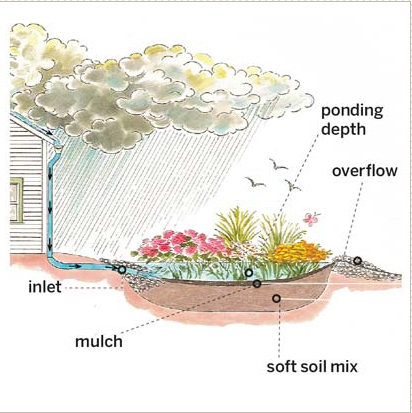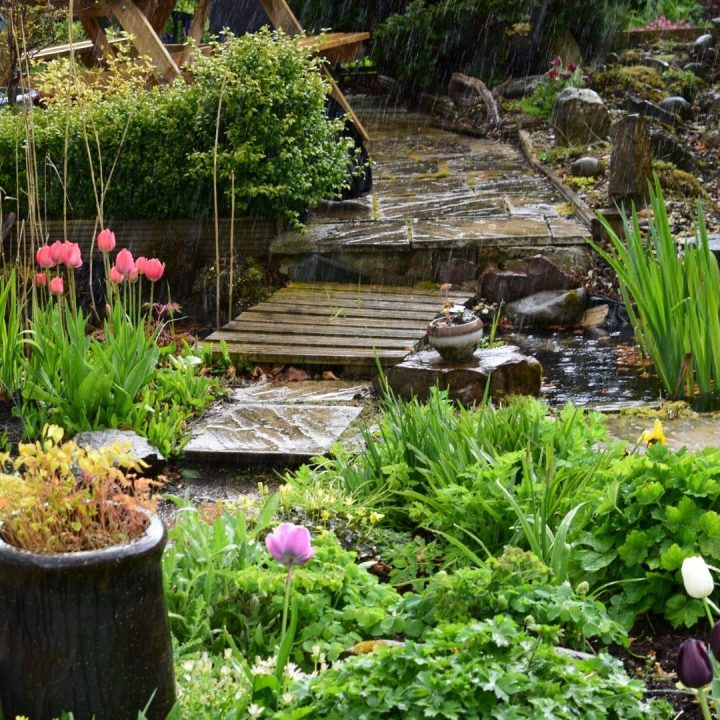Rain Gardens are Beautiful, Practical and Environmentally Friendly!
Rain gardens are a brilliant idea designed to grow plants with the flow of rainwater. Instead of fighting Mother Nature, work with her! Water diverted through a rain garden filters and cleans water, with less waste. It just makes sense.
The fancy name for rain gardens is bioretention facilities[1]https://en.wikipedia.org/wiki/Bioretention
Rain gardens are a win-win for our plants and the environment.
Rainwater directed into rain barrels and prepared areas with plants can be used to create beautiful rain gardens that water your plants as well as for developing natural habitat for wildlife.
You will be inspired by this captivating article and concept on rain gardens excerpted from an article by Jeanne Huber for This Old House Magazine.com.

Benefits of Rain Gardens for Your Yard and Neighborhood
- Rain garden designs can put water to work for you by directing it where you want it to go
- Reduce water saturating septic lines in rural areas
- Minimize polluted runoff water in urban areas washing across chemically treated lawns
- Minimize impact of pollution washing over impervious surfaces like parking lots
- Reduce flooding and erosion (saves soil)
- Make an attractive feature in your yard
- Cut down on water pollution in storm sewers
- Helps mitigates the impact of dry spells
Have a look at this step-by-step article on rain gardening written by Jeanne Huber for This Old House Magazine. She starts with this lead-in.

“During a downpour at a typical house in many municipalities, water gushes out of downspouts, across lawns treated with pesticides and fertilizers, into an oily street, and, finally, down a storm drain that dumps that pollution along with the water into a stream, river, or bay.
By building a rain garden, you can divert your gutter water into an attractive planting bed that works like a sponge and natural filter to clean the water and let it percolate slowly into the surrounding soil.
Installing a rain garden isn’t difficult if you’re willing to dig or you bring in machines to help. Ask your local Cooperative Extension Office for specifics about soil mix, garden size, and plants for your area. Then you’re ready to build.”
~Jeanne Huber, for This Old House Magazine[2]https://www.thisoldhouse.com/toh/how-to/intro/0,,20517496,00.html

For those who wish to learn more about this marvelous way to conserve and create beauty, here are some top-notch reference materials.
Building a Rain Garden
Now that we’ve presented the basics, here’s a video by rain garden enthusiasts out in Washington State who decided to harvest the runoff from their property. As you’ll see, there are lots of ways to do this.
And of course this — and ideas like this — can be done anywhere.
Plants, Shrubs and Trees for Rain Gardens
Excerpted from list by Laurie Danko for Penn State Extension
Wet Zone 1
This area will be the deepest and hold the most water for the most amount of time. The plants listed below can tolerate standing water for a period of time, and most are also good at retaining soil.
Shrubs for Rain Gardens – Wet Zone 1
You’re better off procuring the bulk of plants needed from your local nursery. Call them before you go to see if they have most of the items you want to save time. If not, they may be able and willing to order them for you. We’ve searched for these and found that some of them can be ordered through Amazon, so we’ve provided a few links for that.
- Black chokeberry (Aronia melanocarpa)* – edible berries high in vitamin C
- Buttonbush (Cephalanthus occidentalis)* – not edible, but attractive to hummingbirds
- Elderberry (Sambucus canadensis)* – highly popular for edible, medicinal berries
- Ninebark (Physocarpus opulifolius)* attractive foliage and flowers good for pollinators; medicinal with caution; but, can attract pests: aphids, spiraea leaf beetle, and moth caterpillars[3]https://nativeplants.evergreen.ca/search/view-plant.php?ID=00496
- Possumhaw (Viburnum nudum)* – Edible but bitter berries, medicinal with care[4]https://www.pfaf.org/user/Plant.aspx?LatinName=Viburnum+nudum
- St. Johnswort (Hypericum densiflorum)* – edible leaves and flowers, well known medicinal[5]https://www.ediblewildfood.com/st-johns-wort.aspx" target="_blank" rel="noopener noreferrer">https://www.ediblewildfood.com/st-johns-wort.aspx
- Silky dogwood (Cornus amomum)* – Edible berries, medicinal bark, can also be used for brushing teeth[6]https://www.pfaf.org/user/Plant.aspx?LatinName=Cornus+amomum
- Smooth alder (aka Tag alder) (Alnus serrulata)* – Bark has medicinal benefit[7]https://practicalplants.org/wiki/Alnus_serrulata
- Spicebush (Lindera benzoin)* – Fragrant, edible and medicinal, Spicebush is a good one to plant![8]https://www.pfaf.org/user/Plant.aspx?LatinName=Lindera+benzoin
- Swamp azalea (Rhododendron viscosum) – Aromatic and lovely, good for pollinators like birds and bumblebees but poisonous to humans.
- Swamp rose (Rosa palustris) – petals and rosehips, edible and medicinal[9]https://ouroneacrefarm.com/10-shrubs-wildlife-friendly-edible-landscape/
- Wild raisin, aka Teaberry (Viburnum cassinoides)* – edible and medicinal, fruit,
Winterberry (Ilex verticillata)*
Find ideas for edible hedges here.
List created by Lauri Danko, March 2005, Revised June 2006 for Extension.psu.edu[10]https://extension.psu.edu/plants/gardening/eco-friendly/rain-gardens/plants-rain-gardens
Perennials Plants and Ferns for Rain Gardens – Wet Zone 1
- Blue flag iris (Iris versicolor)
- Blue vervain (Verbena hastata)*
- Boneset (Eupatorium perfoliatum*)
- Cardinal flower (Lobelia cardinalis)*
- Cinnamon fern (Osmunda cinnamomea)*
- Golden ragwort (Senecio aureus)*
- Goldenrod (Solidago patula, S. rugosa)*
- Great blue lobelia (Lobelia siphlitica)*
- Green bullrush (Scirpus atrovirens)
- Horsetail (Equisetum species)
- Marsh marigold (Caltha palustris)*
- Milkweed / swamp milkweed (Asclepias incarnata)*
- Monkey flower (Mimulus ringens)
- New England aster (Aster novae-anglia)*
- New York aster (Aster novi-belgii)
- Royal fern (Osmunda regalis)
- Seedbox (Ludwigia alternifolia)
- Sensitive fern (Onoclea sensibilis)*
- Sneezeweed (Helenium autumnale)*
- Soft rush (Juncus effusus)*
- Swamp rose mallow (Hibiscus moscheutos)
- Swamp sunflower (Helianthus angustifolius)*
- Switchgrass (Panicum virgatum)*
- Tussock sedge (Carex stricta)
- White turtlehead (Chelone glabra)*
- Woolgrass (Scirpus cyperinus)*
Trees for Rain Gardens – Wet Zone 1
- Bald cypress (Taxodium distichum)*
- Birch (Betula lenta, Betula nigra)*
- Black gum (Nyssa sylvatica)*
- Black willow (Salix nigra)*
- Hemlock (Tsuga canadensis)*
- Pin oak (Quercus palustris)
- Pond pine (Pinus palustris)*
- Red maple (Acer rubrum)
- Swamp oak (Quercus bicolor)
- Sweet gum (Liquidambar styraciflua)*
- Sycamore (Plantanus occidentalis)*
*Note: Species noted with an asterisk (*) are also typically suitable for Zone 2 of the rain garden.
Find information on edible tree leaves here.
Zone 2 – Mesic – Middle Zone 2
This area will hold water but will drain much sooner than Zone 1. This zone is likely to hold several inches of water during and immediately after a rain event, depending on construction of the rain garden.
Shrubs for Rain Gardens – Middle Zone 2
- American beautyberry (Calicarpa americana)*
- Broad-leaved meadowsweet (Spirea latifolia)
- Inkberry (Ilex glabra)
- Narrow-leaved meadowsweet (Spirea alba)
- Red-osier dogwood (Cornus sericea)
- Sweet pepperbush (Clethra alnifolia)
- Virginia sweetspire (Itea virginica)
*About the American Beautyberry (Calicarpa Americana) – Great for Jelly and as a Bug Repellent
From Green Deane of EatTheWeeds.com
One of my students, Fred, does a lot of foraging and has lived his life in mosquito-ladened Florida. He reports: [Beautyberry’s] “jelly is awesome but I really love the beautyberry for its insect repellent properties.
After learning about this from a Green Deane class and being an avid forager myself I decided to use the beautyberry as a bug repellent so it wouldn’t slow down my summer foraging (Florida summer mosquitoes can be horrible). I pretty much chopped up a plant(leaves and stems) and boiled it in a pot and let it cool and strained the brown liquid into my blender, about 1 1/2 cups. In a separate pot I warmed some organic neem oil (1 cup) with 1 ounce of beeswax until melted. Then you turn the blender on and pour in the oil mixture very slowly and it becomes a cream. I have to say hands down the best insect repellent ever! Because its a creme on july/august days one application is all you need for the entire day even when your sweating.”
Perennials for Rain Gardens – Middle Zone 2
- Blue false indigo (Baptisia australis)
- Blue star (Amsonia tabernaemontana)
- Boltonia (Boltonia asteroides)
- Bottlebrush grass (Hystrix patula)
- Broomsedge (Andropogon virginicus)
- Culvers root (Veronicastrum virginicum)
- Mistflower (Eupatorium colestinum)
- Obedient plant (Physotegia virginiana)
- Threadleaf coreopsis (Coreopsis verticillata)
Trees for Rain Gardens – Middle Zone 2
- Fringetree (Chionanthus virginicus)
- Ninebark (Physocarpus opulifolius)
- Paw paw (Asmina triloba)
- Red maple (Acer rubrum)
- Serviceberry (Amelanchier arborea, A.canadensis and A. laevis)
Note: See also the plants listed in Zone 1 marked with an asterisk (*).
The Pawpaw fruit tree has the added benefit of being an indigenous tree with an amazing fruit.
Zone 3 – Rain Garden Transition Zone
The upper or transition zone between the rain garden and the non-garden area. This area will receive water infrequently; during very heavy rain events and will drain the fastest. It will be the most similar to typical garden areas, depending on the individual’s watering practices. Almost any typical garden plant will work in this zone. Just be sure to use native plants to enhance wildlife habitat.
Shrubs for Rain Gardens – Transition Zone 3
- American cranberry bush (Viburnum trilobum)
- Black chokeberry (Aronia melanocarpa)
- Bush cinquefoil (Potentilla fruticosa)
- Fragrant sumac (Rhus aromatica)
- Gray Dogwood (Cornus racemosa)
- New Jersey tea (Ceanothus americanus)
- St. Johnswort (Hypericum densiflorum)
- Sweet pepperbush (Clethra alnifolia)
- Virginia sweetspire (Itea virginica)
- Witch hazel (Hammamelis virginiana)
- Yellow root (Xanthorhizza simplicissima)
Perennial Plants for Rain Gardens – Transition Zone 3
- Anise hyssop (Agastache foeniculum)
- Blazing star (Liatris spicata)
- Blue star (Amsonia tabernaemontana)
- Boltonia (Boltonia asteroides)
- Butterfly weed (Asclepias tuberosa)
- Calico aster (Aster lateriflorus)
- Evening primrose (Oenothera speciosa)
- Golden aster (Chrysopsis mariana)
- Green and gold (Chrysogonum virginianum)
- Mistflower (Eupatorium colestinum)
- Threadleaf coreopsis (Coreopsis verticillata)
- Tickseed (Coreopsis tinctoria)
Trees for Rain Gardens – Transition Zone 3
Buckeye (Aesculus pavia and A. parviflora)
Carolina silverbell (Halesia caroliana)
Staghorn sumac (Rhus typhina)
List created by Lauri Danko, March 2005, Revised June 2006 for Extension.psu.edu[11]https://extension.psu.edu/plants/gardening/eco-friendly/rain-gardens/plants-rain-gardens
Demonstration Rain Gardens
Visit this interactive map of demonstration rain gardens in New Jersey.

We are an online gardening publication sharing all things garden related! Including urban farming, family gardening, homesteading, gardening for profits, and more. We’re all about growth!
References

